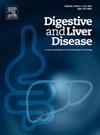急性肝衰竭的肝移植:帕多瓦移植中心活动的评价
IF 3.8
3区 医学
Q1 GASTROENTEROLOGY & HEPATOLOGY
引用次数: 0
摘要
根据ELTR的数据,急性肝衰竭(ALF)占欧洲所有肝移植(LT)的8%。然而,只有50%因ALF住院且病情严重的患者实现了肝移植。在接受肝移植的患者中,观察到患者生存率显著提高。本研究的目的是:a)评估因ALF接受肝移植的患者的人口学和临床变量;b)评估移植后移植物和患者的生存及并发症,确定可能导致预后不良的危险因素;C)分析收集的变量在不同时期的趋势。方法1991年至2025年间在帕多瓦移植中心接受肝移植治疗的所有ALF患者纳入研究。分析供体、移植物和受体变量。病因学和时间段(1991-2007年与2008-2025年)进行了比较。然后将死亡患者的特征与存活患者的特征进行比较,并采用单因素和多因素分析探讨与死亡相关的危险因素。结果共纳入58例患者(55.2%为女性,19%为儿童)。大多数ALF病例病因不明(32.8%)或与hbv相关(31%)。其次是DILI 5例,蘑菇中毒4例。移植时MELD平均评分为34,4 (SD: 5,0)。1年、3年和5年的患者和移植物总体生存率分别为76%和67%,76%和67%,74%和65%。移植后最常见的并发症是感染(40%),其中2/3为细菌性感染,其次是胆道吻合口狭窄(18%),心血管并发症(16%)。此外,12.7%的患者接受了再次移植。最常见的死亡原因是感染(40.9%)。结论肺叶移植术后生存率高,大部分死亡发生在移植后1年内。感染是移植后最常见的并发症,也是导致死亡的主要原因。建立一个包括所有ALF病例的国家登记处是有必要的,以便确定没有LT的不良预后的真正预后因素。本文章由计算机程序翻译,如有差异,请以英文原文为准。
Liver transplantation for Acute Liver Failure: evaluation of Padua Transplant Center activity
Background
According to data from ELTR, Acute Liver Failure (ALF) accounts for 8% of all liver transplants (LT) in Europe. However, only 50% of patients hospitalized for ALF, who present with a high severity of disease, achieve LT. Among those undergoing LT, a significant improvement in patient survival was observed.
Aims
The aims of the study were: a) to assess the demographic and clinical variables of patients who underwent LT for ALF; b) to evaluate graft and patient survival and complications occurring after LT, identifying possible risk factors for poor outcome; c) to analyze trends in the collected variables across different time periods.
Methods
All patients who underwent LT for ALF at the Padua Transplant Centre between 1991 and 2025 were included in the study. Donor, graft and recipient variables were analyzed. Aetiologies and time periods (1991-2007 vs. 2008-2025) were compared. Then characteristics of deceased patients were compared with those of surviving patients and risk factors associated with death were investigated using univariate and multivariate analysis.
Results
58 patients (55,2% female, 19% pediatric) were included in the study. Most ALF cases had an undetermined etiology (32,8%) or were HBV-related (31%). This was followed by 5 cases of DILI and 4 cases due to mushroom poisoning. The mean MELD score at transplantation was 34,4 (SD: 5,0). Overall patient and graft survival at 1, 3 and 5 years was 76% and 67%, 76% and 67% and 74% and 65% respectively. The most common post-transplant complications were infections (40%), 2/3 of which were bacterial, followed by biliary anastomosis stenosis (18%), cardiovascular complications (16%). Additionally, 12,7% of patients underwent re-transplantation. The most frequent cause of death was infection (40,9%).
Conclusions
LT for ALF is associated with excellent survival rate, with most deaths occurring within the first year post-transplant. Infections are the most common post-transplant complication and the leading cause of death. The establishment of a national registry including all ALF cases is warranted, to allow the identification of true prognostic factors for a poor prognosis without LT.
求助全文
通过发布文献求助,成功后即可免费获取论文全文。
去求助
来源期刊

Digestive and Liver Disease
医学-胃肠肝病学
CiteScore
6.10
自引率
2.20%
发文量
632
审稿时长
19 days
期刊介绍:
Digestive and Liver Disease is an international journal of Gastroenterology and Hepatology. It is the official journal of Italian Association for the Study of the Liver (AISF); Italian Association for the Study of the Pancreas (AISP); Italian Association for Digestive Endoscopy (SIED); Italian Association for Hospital Gastroenterologists and Digestive Endoscopists (AIGO); Italian Society of Gastroenterology (SIGE); Italian Society of Pediatric Gastroenterology and Hepatology (SIGENP) and Italian Group for the Study of Inflammatory Bowel Disease (IG-IBD).
Digestive and Liver Disease publishes papers on basic and clinical research in the field of gastroenterology and hepatology.
Contributions consist of:
Original Papers
Correspondence to the Editor
Editorials, Reviews and Special Articles
Progress Reports
Image of the Month
Congress Proceedings
Symposia and Mini-symposia.
 求助内容:
求助内容: 应助结果提醒方式:
应助结果提醒方式:


